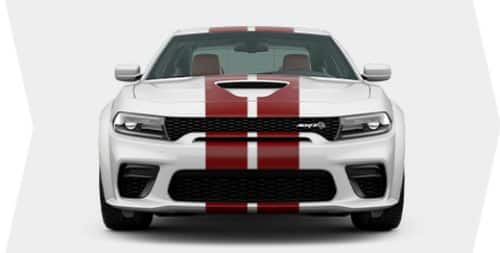
The massive displacement engines provided by Detroit OEM's (previously called The Big Three GM Ford Ford Chrysler) were what fueled the early days of muscle car mania. The Japanese and German invasion of muscle cars began in the 1960s. Daimler, Volkswagen and Toyota were the car makers, while Nissan, Mazda and Mitsubishi were the Japanese carmakers. This invasion was the birth of the first American muscle cars.
1970 Chevrolet Chevelle SS 454 LS6
The 1970 Chevrolet Chevelle's LS6 motor is one of today's most famous muscle cars. GM rated LS6 at 450 horsepower, but real-world numbers place it closer to 500. The LS6 engine has a huge torque curve that is unmatched by any other horsepower rating. It was admired by drivers throughout history. The torque produced by big-inch motors can shred tires. The Chevelle LS6 was a true beast on the track.
The LS6 engine was key to winning the horsepower wars in the late 1960s and early 70s. The Chevrolet Chevelle SS454 LS6 engine was the secret weapon during the 1970 muscle car fight. The big engine in the Ford 428 Cobra Jet, Chrysler's 440 wedge, and Dodge 426 Hemi was a big one, but the LS6 option was only available for a single model year, 1970. Buick also sold a 455 cubic-inch (7.46L), engine in 1970.

1970 Plymouth Duster
The performance-oriented, compact 1970 Plymouth Duster was a muscle car that put bigger cars to shame. The compact car featured a 340-cubic-inch V8 engine and a sporty, aerodynamic hood that allowed for maximum performance. Although the Valiant was similar in appearance to its hood scoop, front end sheet metal and design, the Duster's cowl-back design stood out. Duster models began at $2,172 in 1970 and could be purchased as either a two-door coupe, or sedan.
The Plymouth Valiant’s flagship, the duster, was the iconic product. It was launched in 1970, and it was sold for seven consecutive years. The 340 cubic-inch V-8, which produced 275 horsepower, was the most powerful. Two slant sixes were available, as well as a 318-cubic inch V-8. In 1970, the Plymouth sporty car was the most loved brand. Despite the fact that it was affordable, many buyers loved its performance.
1970 Coronet Super Bee
With its iconic look and unstoppable horsepower, the 1970 Coronet Super Bee remains one of the most recognizable cars of all times. This Dodge muscle car not only has stunning looks but it also has an amazing restoration that is impeccable and detailed. Future Classics has the expertise to make your dreams come true if you have always wanted one of these legendary cars. Our team of experts can assist you in the restoration process.
This iconic muscle car was part the Scat Pack. Its nose design was completely restyled, and its base price was reduced to $3074. The car's color choices, like Panther Pink and Red, were created to have maximum impact. This color was only used on a few cars, making it rare. Despite this unique style of painting, 1970 saw a decline in sales.

1970 Pontiac Trans Am SD-455
The storied 1970 Pontiac Trans Am is the sexiest of the classic muscle cars. This supercharged four cylinder engine produced 290 horsepower (270 PS) and was the first car with such a high compression ratio. Pontiac engineers spent the summer developing the engine, which became the basis of their SD-455 muscle car. Despite its high compression ratio, it produced only 290 SAE horsepower.
A 16-yearold car enthusiast found a 36K-mile surviving vehicle in the spring 1977. The Trans Am was the first American car to have a hood sticker. It was also driven by many A-list celebrities. Burt Reynolds, who owned a Trans Am and drove the car on many of his movie sets, is perhaps most famous. It's not hard to see why this car is called the "Screaming chicken".
FAQ
What's the difference between a mechanic and an automotive technician?
These two jobs are very similar but not identical. Both a mechanic and an automotive technician can repair cars.
A mechanic must be skilled in manual dexterity and able to complete simple tasks quickly. They should be able to accurately diagnose problems and repair them efficiently.
An automotive technician is required to have more technical knowledge than a mechanic. They should be able read blueprints and use tools like drills and wrenches.
They must be able and competent to safely perform complicated procedures. They must also be familiar with different types of engines and electrical systems.
They must also understand the interplay of different parts.
A mechanic typically earns less than an automotive technician. There are many job opportunities in both.
Is being an auto mechanic a promising career choice?
The automotive industry is full of exciting opportunities for those who are dedicated to excellence. This field requires hard work and the willingness to learn from others.
Because you will be spending most of your time communicating with customers and employees, you will need excellent communication skills. It's important to be flexible and willing to travel. This will make commutes difficult.
You can take classes at universities and community colleges if you are interested in a career as an automotive technician. Many schools offer programs specifically designed for students interested in auto repair, sales, or customer service.
If you decide to pursue a degree, you should study mechanical engineering. You can earn a bachelor's in as little four years.
Many employers will hire graduates straight out from school. Therefore, it is a good idea to look for employment while still pursuing part-time studies.
After you complete your education, you may need to undergo some type of training before you can become an automotive technician.
You will need to pass the Automotive Service Excellence certification exam. This test covers topics including engine maintenance, brakes, steering systems, suspension, and more.
Once you've passed the ASE test, you can apply for a license issued by the National Institute for Automotive Service Excellence.
You can perform repairs on private cars by obtaining a license. You will be compensated based on how many services you performed.
It's important to note that not all states require licensing. However, if you plan to work outside your home state, you'll need to obtain a license.
Some states do not issue licenses until they have received a certain amount or training. This could be you.
What length of an automotive course is it?
A course in automotive lasts three years.
The first year is spent on theory, learning all about cars. The second year is dedicated towards practical training. This includes learning how to drive, fix engine problems, and doing other maintenance jobs around your car. The final year is spent doing a placement at a local garage, which gives you experience in fixing real-world problems.
Does it matter where I go to college?
Not really. There are no differences between colleges when it comes to getting into the automotive industry. But, there are better programs at some schools than others. Look elsewhere if you want something more niche.
What can I do to fix my car as an hobby?
It's a great hobby to take on if you are passionate about cars. It is possible to learn about cars, repair them, purchase parts, or simply enjoy them. This would be a wonderful hobby if you're looking to find something completely different.
It isn't easy to turn it into a full time job. This requires dedication and hard work. It will also require a large amount of investment.
If you don't have any good reasons to be involved in cars, it may be better to just let it go.
What type of job is there for a car mechanic?
Car mechanics can find work in three areas:
-
Automotive repair shops
-
Dealerships
-
Independent garages
Automotive repair shops
This is where most people consider becoming a mechanic. It's actually the easiest way to start. Either work for someone else's shop or you can start your own.
If you choose to work at a store, you need to join a union. Once you're accepted into the union, you'll receive training from the union.
After completing the training, you'll be ready to start work.
You will need to register if your garage is going to be open. After you register, you will be required to meet specific standards.
Once you register, you'll receive a license that allows you to operate your garage.
You can sell spare parts or do minor repairs with your license. It won't allow you to fix major engine problems.
You will be expected to sell spare parts and also offer guidance and advice to customers.
Dealership jobs
Most dealerships employ mechanics who can specialize in a particular area of the car. They may be trained to replace or repair tires, or they may specialize in brakes.
Some dealers also have general mechanics that can handle all aspects.
These positions often require applicants to undergo specific training before being allowed to work. Employers are able to choose which candidates will best suit their position.
Some dealerships hire students straight out of college. These graduates have no difficulty learning about cars because they already know the basics and principles of mechanical engineering.
Independent garages
Independent garages do not belong to any dealership. Instead, independent garages tend to concentrate on providing high-quality services.
Independent garages can pay higher wages because they aren't associated with any company. This makes them generally more well-paid than jobs at dealerships.
However, independent garages may not be better places to work. Many owners prefer to run their businesses themselves rather than delegate responsibility to employees.
You may find yourself working for long hours and not having control over the day.
Expect to earn lower salaries than if you were working in a dealership.
It's possible to switch between jobs. It is possible to switch between different types of jobs if your current employer would prefer you to work at a dealer.
Alternativly, you can apply directly to the garage owner if you are interested in working at an independent garage.
The bad news is that finding a new job isn't always easy. There are many factors that affect how much you make.
You might also consider the vehicle type you repair, and whether extra labor is charged.
Statistics
- There were 749,900 jobs available for automotive service technicians and mechanics in 2016, which is expected to grow by six percent through 2026. (jobhero.com)
- According to the BLS, total auto technician employment is expected to exceed 705,000 by 2030. (uti.edu)
- 52% of Mechanics in the United States think their salaries are enough for the cost of living in their area. (indeed.com)
External Links
How To
How to Become an Auto Technician
A technician who works on vehicles is an automotive technician. He/she works at automotive shops, garages or service centers. Customers can rely on him/her to fix their cars, trucks and motorcycles. An automotive technician must have the ability to quickly diagnose and fix problems.
A person who wants to work as an automotive technician should first obtain an associate degree from a vocational school. After completing the program, he/she must take the National Institute for Automotive Service Excellence certification exam. ASE stands for American Society of Mechanical Engineers. Two sections make up the ASE certification examination. One section tests mechanical knowledge; the second section tests practical skills. To take the test, you must visit one of the approved testing locations. These testing sites can be found online and through your local dealer.
After passing the test, a candidate must pass an examination in order to be licensed as an automotive technician. This process is different depending on where you live. Some states require that candidates attend training courses, while others permit them to learn independently. Some states issue licenses to technicians as soon as they get their license. Others wait until they have worked at least six months as an automotive technician.
Apply to your local dealership to become an automotive technician. New employees are usually apprentices when they first get hired. Apprenticeship programs last about three years. Students learn basic repair skills such as changing oil and adjusting brakes, changing tires, cleaning spark plugs and inspecting engine compartments. Some students are taught how to repair engines and replace transmission fluids. Many schools offer classes during normal business hours. However, some schools offer evening classes if needed.
Once a student is done with his/her apprenticeship he/she can become a master journeyman. Journeymen typically spend four to five years learning how to install major systems, such as transmissions, differentials, steering gear, suspensions, and drive shafts. You will also learn how to repair complicated electrical components, as well as how to remanufacture engines and rebuild transmissions. Because they have the experience and knowledge to do the job right, employers love hiring journeymen.
Candidates who pass the required exams are eligible for a license. According to the Bureau of Labor Statistics, nearly 1.7 million automotive mechanic jobs were available in 2010. This number was expected increase 18% between 2009 - 2020. If a candidate decides to open his/her own shop, he/she should prepare to invest many thousands of dollars in equipment and supplies.
The salary for an automotive technician depends on several factors, including the type of employer, location, education level, and experience. A jobless person can expect to make $20,000 per year. Someone who has only a highschool diploma could earn around 21,000 dollars per year. A bachelor's degree is equivalent to approximately $24,000 annually. Technicians with bachelor's degrees earned about $27,000 per year. Masters' degree holders earn around $32,000 per annum. Salary increases are common, so a professional who earns less than $30,000 now could reasonably expect to earn $40,000 or more in just a few years.